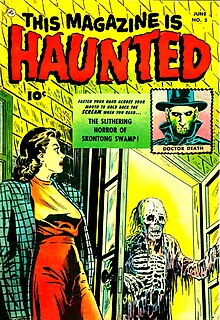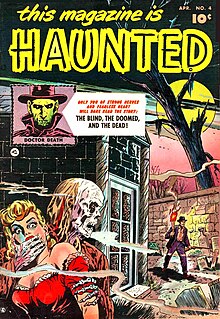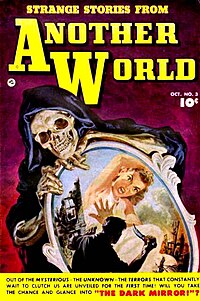This Magazine Is Haunted
| This Magazine Is Haunted | |
|---|---|
 Haunted #5, published by Fawcett Comics (June 1952). Cover by Sheldon Moldoff | |
| Publication information | |
| Publisher | Fawcett Comics Charlton Comics |
| Schedule | Bimonthly |
| Format | Ongoing series |
| Genre | |
| Publication date | Vol. 1: Oct. 1951 – Dec. 1953 (Fawcett) Feb. 1954 – Nov. 1954 (Charlton) Vol. 2: July 1957 - May 1958 |
| No. of issues | Vol. 1 : 14 (Fawcett) 7 (Charlton) Vol 2.: 5 |
| Main character(s) | Doctor Death |
| Creative team | |
| Created by | Sheldon Moldoff |
| Artist(s) | Sheldon Moldoff, Steve Ditko |
| Editor(s) | Will Leiberson, Al Jetter |
This Magazine is Haunted was a horror comic originally published by Fawcett[1] between 1951 and 1953. Running 14 issues, it was the first of Fawcett's supernatural line; a string of titles which included Beware! Terror Tales, Worlds of Fear, Strange Suspense Stories, and Unknown Worlds.
After Fawcett ceased publication, This Magazine is Haunted was sold to and published by Charlton Comics from 1954 to 1958.
Format
Debuting with a cover date of October 1951, This Magazine is Haunted was Fawcett's first successful attempt to enter the lucrative horror market with a comic devoted specifically to supernatural fiction.[2] The book represented a break from Fawcett's more familiar product, which ranged from superheroes (Captain Marvel) to movie adaptations and teen humor. Created by Sheldon Moldoff and edited by Will Leiberson and Al Jetter, the book was loosely modeled after EC's New Trend, particularly their highly successful horror titles.[3]
Like its better-known competitors, This Magazine is Haunted was notable for its black humor and frequent O. Henry climaxes. Drawing on the considerable creative resources of the Fawcett stable, Haunted storylines dealt with the standard horror themes of the period: vengeance from beyond the grave, macabre retribution and 'dark' justice, all of which were presented with an appropriate level of irony.

Human folly played a key role in many stories; characters were constantly led into disaster by their own greed, stupidity or outright corruption. Numerous plots revolved around violent criminals meeting grisly but entirely deserving fates, while others featured hapless bystanders trapped in bizarre or terrifying circumstances.
Comics historian Stephen Sennitt describes the Fawcett line as "genuinely eerie"[4] in contrast to EC's more visceral approach.[5]
Aside from the evident cinematic influences, Haunted and its companions followed at least two literary traditions derived from the pulp literature of the previous decades. The first was the Crime-Horror imagery of magazines like Black Mask or Flynn's Detective Fiction, which emphasized murder, violence, and horrific crimes. Many authorities believe that the tradition was passed down to the 50s horror genre via the crime comics of the later forties;[6] Haunted featured numerous stories combining the two areas.
Of course, by far the most potent influence on This Magazine is Haunted was the horror comic genre itself, which according to Watt-Evans, represented around one-sixth of the comics market at its 1954 peak.
Doctor Death

Once more following EC's example, Haunted featured mainly non-continuing stories narrated by a suitably malevolent host, the cadaverous Doctor Death.[7] Resembling a decaying corpse dressed as a Victorian undertaker, Doctor Death played much the same role as the Crypt Keeper in Tales From the Crypt, breaking the fourth wall to provide explanations and plot details. Unlike EC's so-called "GhouLunatics" however, Dr. Death frequently orchestrated events in the narrative, acting as the hand of Fate and even driving the characters towards their ultimate destruction. To this end, he was capable of taking on human form to interact with his intended victims, feeding them bad advice or (somewhat maliciously) betraying their trust at crucial moments.[8]
Dr. Death resembled Mr. Crime, the cartoon mascot from Lev Gleason Publications' Crime Does Not Pay. Both wore vintage clothing and had, to varying degrees, an inhuman appearance.
First appearing on the cover of Haunted #1, Doctor Death was the series' host until its cancellation in 1953. He returned for a number of issues when the magazine was acquired by Charlton Comics in 1954. As rendered by Charlton stalwart Steve Ditko, Doctor Death took on a progressively less skeletal appearance.
The Beyond
Haunted was notable for employing "The Beyond" as a unifying element to many of its storylines. While the idea was not used consistently, it became a recurring plot device in all of Fawcett's horror titles, sometimes playing an essential role in the narrative.
The Beyond was a mysterious plane of existence which occasionally encroached on the physical world. A shadowy limbo vaguely akin to the Afterlife, it served as the source of the many supernatural menaces which threatened the "Realm of the Living". In a number of cases, it was a grey, lifeless Purgatory inhabited by rotting corpses; in others, a place of perpetual torment akin to Hell (although it was never specifically defined as such).
The Beyond seemed to be the abode of all of humanity's worst fears; vampires, ghosts and demons existed alongside dragons, witches and harpies. All seemed generally hostile towards mankind; some periodically crossed over to prey on selected victims or to seek vengeance on former tormentors. The traffic appeared to flow in both directions; mortals could inadvertently find themselves trapped in the Beyond before the end of their natural lives.
Access to the Beyond took numerous forms. Ghostly express trains made midnight runs to the other side, carrying the spirits of the recently departed. Phantom cruise liners ferried moldering passengers through the Sea of the Dead. Unwary travellers often found themselves making a one-way trip on the Road to Nowhere. Sometimes, mechanised transport was completely unnecessary - swamps, caves and haunted houses all seemed to lie within the outer boundaries of The Beyond.
Sale to Charlton
Along with many other titles of a similar vein, This Magazine is Haunted came under fire during the anti-comics backlash of the early fifties (although generally speaking, its content was not quite as visceral as its rivals). Ironically, this was not the reason for the title's cancellation; Fawcett dropped its entire comics line in 1953, largely as a result of an industry-wide sales slump and a long-running legal battle with DC Comics.
Fawcett sold most of its properties to Charlton Comics in 1954, a deal which included the four horror titles. Evidently, Haunted was successful enough to continue publishing under its original numbering, starting with #15 (February 1954). The final issue of this 1st Charlton run was #21 (November 1954). For a time at least, Charlton attempted to maintain the moody atmosphere of its predecessor, even retaining the services of Doctor Death as the series' narrator.[9] While not quite up to Fawcett's standards artistically, Charlton's run was distinguished by some of Steve Ditko's earliest work in the supernatural genre. After the establishing of the Comics Code in 1954, the content was toned down considerably, dealing with magic, mystery and suspense rather than with outright horror.
The magazine was rebooted two years later, restarting with #12 in 1957. Doctor Death was replaced by Doctor Haunt (possibly designed by Ditko, by now the title's lead artist). The comic continued bi-monthly another two years despite the financial problems besetting the comics industry at the time. The final issue of the 2nd Charlton run was #16 (May 1958).
Footnotes
- ^ Although Haunted's indicia identifies Fawcett as the publisher, the magazine never carried the company's logo on its covers. Speaking in an interview with Roy Thomas, Haunted's creator Sheldon Moldoff stated that Fawcett had been very reluctant to carry any horror titles, and only agreed to publish Haunted after the genre was too popular to ignore. See Alter Ego, vol. 3, #4 (Spring 2000).
- ^ Schelly, William (2013). American Comic Book Chronicles: The 1950s. TwoMorrows Publishing. p. 47. ISBN 9781605490540.
- ^ As noted by Watt-Evans, Fawcett's horror comics were "loosely modeled after the E.C. format but not directly imitating E.C.'s approach".
- ^ Sennitt, p. 36. Sennitt considers EC's narrative structure to be "formulaic" in comparison to Fawcett's approach. He did, however, rank EC amongst the highest quality publications of the period.
- ^ There were exceptions of course; the cover of Haunted #10 features a severed head on the end of a fishing line, precisely the kind of imagery that anti-comics crusader Fredric Wertham objected to.
- ^ Les Daniels was one of the first to discuss the relationship in Comix: A History of the Comic Book in America, arguing that horror comics were an outgrowth of the popular 'true crime' genre of the 1940s.
- ^ In an interview with Alter Ego's Roy Thomas, Moldoff claims to have approached William M. Gaines with two supernatural titles, signing a contract stipulating that he would be paid a commission if the books were successful. Several months later, when EC's horror comics hit the newsstands, Gaines apparently reneged on the deal, threatening to blacklist Moldoff if he took legal action. Moldoff eventually sold the title - This Magazine is Haunted - to Fawcett Publications for the sum of $100.00 - "and all the work I wanted." From Alter Ego, vol. 3, #4 (Spring 2000)
- ^ EC's ghoulish hosts occasionally also appeared in stories, such as "Horror Beneath the Streets" (The Haunt of Fear #17), a self-parodic tale in which Bill Gaines and Al Feldstein are lured into the sewers and blackmailed into publishing the GhouLunatics' stories.
- ^ It is possible that Charlton simply printed several unpublished issues of Haunted under their own logo. Don Markstein notes in Toonopedia that part of Charlton's acquisition included unused artwork from a number of Fawcett titles.
References
- Daniels, Les. Comix: A History of the Comic Book in America. Mad Peck Studios, 1971.
- Nyberg, Amy Kiste. Seal of Approval: The History of the Comics Code. University Press of Mississippi, 1998.
- Sennitt, Stephen. Ghastly Terror: The Horrible Story of Horror Comics. Manchester, Headpress, 1999.
- Thomas, Roy. "A Moon... A Bat... A Hawk: A Candid Conversation with Sheldon Moldoff." Alter Ego, Vol. 3, no. 4. Reprinted online by Two Morrows Publishing.
- Watt-Evans, Lawrence. "The Other Guys:Pre-code Horror Comics." The Scream Factory no.19, 1996.
External links
- Free downloads of Golden Age Fawcett Comics, including This Magazine is Haunted.



